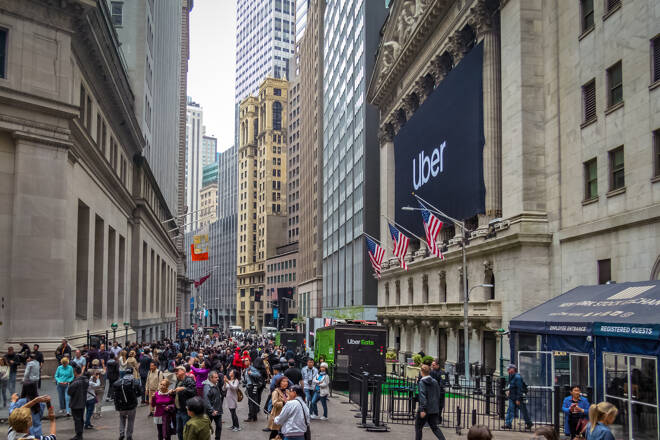Uber Beefs up for Food Fight with $2.65B Acquisition
By:
Earlier this week, Uber unveiled plans to pile on US$2.65 billion worth of muscle in its purchase of Postmates, the San-Francisco-based food delivery company, that will complement Uber Eats. The combined entity is expected to give DoorDash, the US food-delivery market leader, a run for its money.
After the announcement, Uber’s stock jumped six percent on Monday, bringing its advance to nearly 129 percent since its record low on March 18. Having gained over 10 percent since the extended 4th of July weekend, Uber’s shares have also outpaced the week-to-date gains seen respectively in the S&P 500 and the Nasdaq.
Shareholders are hoping that this acquisition would also bolster Uber’s plans for reaching its first-ever quarterly profit, with such ambitions derailed after its global ride-hailing business fell by 70 percent in the wake of the pandemic. Gross bookings registered its first-ever quarterly drop in the January-March period this year, as the orders to stay at home dealt a massive blow to the travel and transportation industry.
Growing appetite for food deliveries, and more
The pandemic however boosted demand for food deliveries, which soared by 52 percent in gross bookings to US$4.68 billion in Q1. The segment also accounted for 23.1 percent of Uber’s gross revenue for the quarter, higher compared to the 18 percent contribution in the prior three-month period, according to Bloomberg data. Postmates’s food-delivery bookings rose about 67 percent in Q2, according to Uber CEO Dara Khosrowshahi.
Set against such a context, it’s of little wonder that Uber is willing to place a bigger bet on the food deliveries segment, as its core offerings contend with the strong headwinds stemming from the pandemic. And with this consolidation in the food deliveries space, there could eventually be some upward pressure on prices as the market discovers its new equilibrium, which bodes well for this Uber segment’s top line.
Beyond bolstering its food deliveries segment, Uber is also hoping to leverage on Postmates’s strength in its online delivery offerings, which brings groceries and daily essentials, among other things, right to customers’ doorsteps. Also this week, Uber rolled out its in-app grocery delivery services for select Latin American and Canadian cities, as it partners with Cornershop, the Chile-based grocery delivery startup in which Uber agreed to take up a majority stake last year.
Uber’s emphasis on delivery-as-a-service should give the company another leg to stand on in its quest for profitability, especially if changed consumer habits from the lockdown-era (i.e. customers are less wiling to venture out of their homes) become sticky.
A sure path to profitability?
Back in May, Khosrowshahi said that the initial timeline for churning out the company’s first-ever adjusted quarterly profit has been pushed back from this year to 2021. To hasten its path to profitability, Uber has reduced over US$1 billion in expenses, getting rid of some non-core businesses while having shed more than a quarter of its staff.
While awaiting the potential synergies to materialize from this combo of profitless companies, with the deal only expected to be sealed in the first quarter of 2021, shareholders are likely to keep themselves busy in the interim, assessing how Uber is faring amid the double-edged sword that is the global pandemic. The impact of Covid-19 is likely to be more pronounced in Uber’s Q2 earnings release slated for August.
It remains to be seen whether shareholders will have the patience to wait for the promise of things to come, and potentially send Uber’s shares much higher from current levels. If it’s anything like I’ve discovered during quarantine, the wait can sometimes be agonizing, akin to trying to supress one’s hunger pangs while waiting for the food delivery order to arrive.
Written on 07/09/20 09:00 GMT by Han Tan, Market Analyst at FXTM
For more information, please visit: FXTM
Disclaimer: This written/visual material is comprised of personal opinions and ideas. The content should not be construed as containing any type of investment advice and/or a solicitation for any transactions. It does not imply an obligation to purchase investment services, nor does it guarantee or predict future performance. FXTM, its affiliates, agents, directors, officers or employees do not guarantee the accuracy, validity, timeliness or completeness of any information or data made available and assume no liability for any loss arising from any investment based on the same.
Risk Warning: CFDs are complex instruments and come with a high risk of losing money rapidly due to leverage. 80% of retail investor accounts lose money when trading CFDs with this provider. You should consider whether you understand how CFDs work and whether you can afford to take the high risk of losing your money.
About the Author
Han Tancontributor
A highly experienced financial journalist and producer with more than seven years of experience gained across some of Southeast Asia’s (SEA) most prominent business broadcasters.
Advertisement
